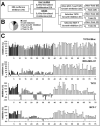Evaluation of a luciferase-based reporter assay as a screen for inhibitors of estrogen-ERα-induced proliferation of breast cancer cells
- PMID: 22498909
- PMCID: PMC4132978
- DOI: 10.1177/1087057112442960
Evaluation of a luciferase-based reporter assay as a screen for inhibitors of estrogen-ERα-induced proliferation of breast cancer cells
Abstract
Estrogens, acting through estrogen receptor α (ERα), stimulate breast cancer proliferation, making ERα an attractive drug target. Since 384-well format screens for inhibitors of proliferation can be challenging for some cells, inhibition of luciferase-based reporters is often used as a surrogate end point. To identify novel small-molecule inhibitors of 17β-estradiol (E(2))-ERα-stimulated cell proliferation, we established a cell-based screen for inhibitors of E(2)-ERα induction of an estrogen response element (ERE)(3)-luciferase reporter. Seventy-five "hits" were evaluated in tiered follow-up assays to identify where hits failed to progress and evaluate their effectiveness as inhibitors of E(2)-ERα-induced proliferation of breast cancer cells. Only 8 of 75 hits from the luciferase screen inhibited estrogen-induced proliferation of ERα-positive MCF-7 and T47D cells but not control ERα-negative MDA-MB-231 cells. Although 12% of compounds inhibited E(2)-ERα-stimulated proliferation in only one of the ERα-positive cell lines, 40% of compounds were toxic and inhibited growth of all the cell lines, and ~37% exhibited little or no ability to inhibit E(2)-ERα-stimulated cell proliferation. Representative compounds were evaluated in more detail, and a lead ERα inhibitor was identified.
Figures






References
-
- Fan F, Wood KV. Bioluminescent assays for high-throughput screening. Assay Drug Dev. Technol. 2007;5:127–36. - PubMed
-
- Inglese J, Johnson RL, Simeonov A, Xia M, Zheng W, Austin CP, Auld DS. High-throughput screening assays for the identification of chemical probes. Nat. Chem. Biol. 2007;3:466–479. - PubMed
-
- Jordan VC. Chemoprevention with antiestrogens: the beginning of the end for breast cancer. Daniel G. Miller Lecture. Ann. N.Y. Acad. Sci. 2001;952:60–72. - PubMed
Publication types
MeSH terms
Substances
Grants and funding
LinkOut - more resources
Full Text Sources
Medical
Miscellaneous

